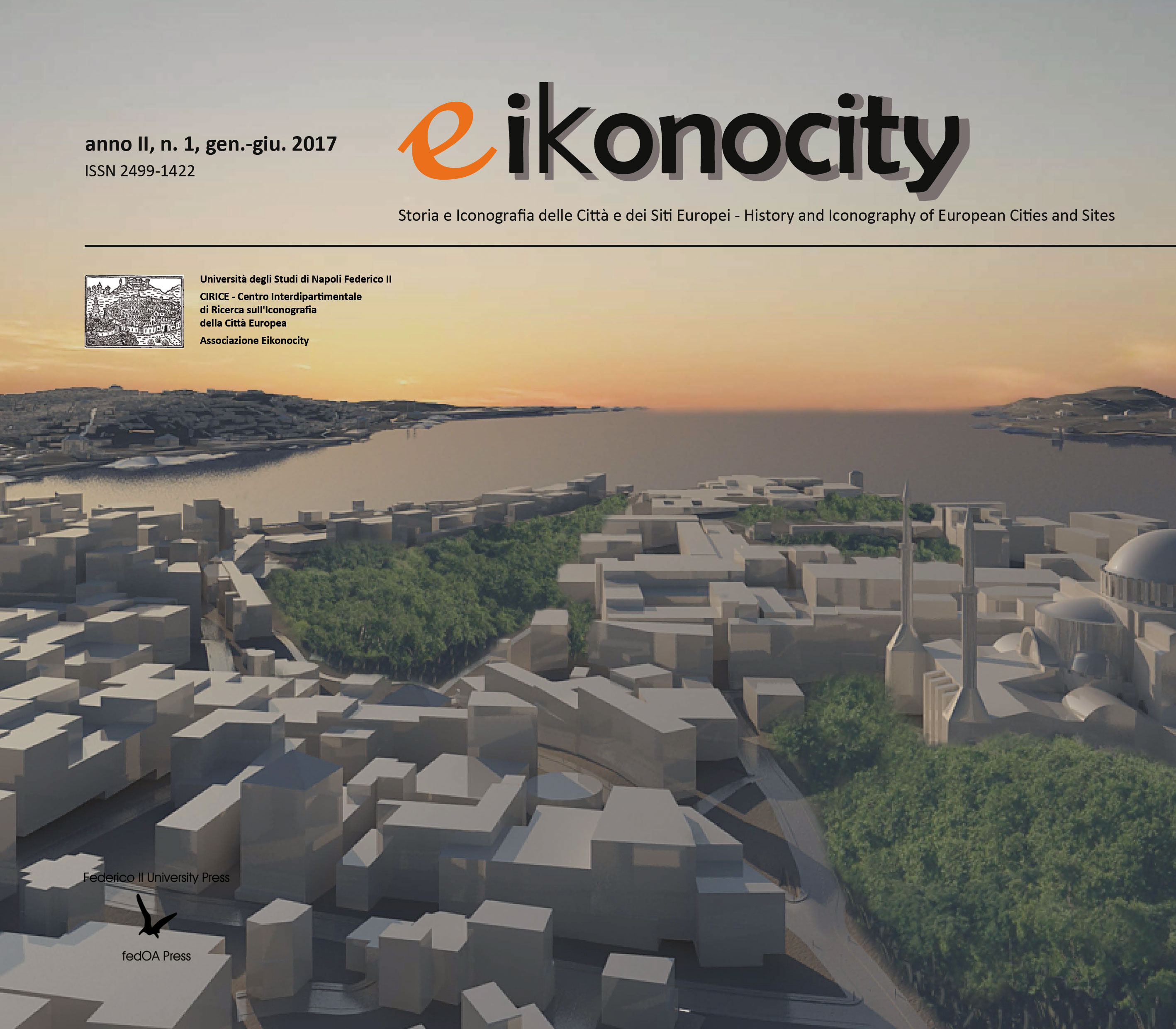Territorio e rappresentazione: lo “sguardo virtuale” dal treno
Abstract
Il territorio della città diffusa viene abitualmente attraversato e percepito da mezzi di trasporto rapidi come il treno. Ripercorrendo le caratteristiche formali della ferrovia e l’evoluzione percettiva favorita storicamente dall’esperienza del treno – sorta di “camera con vista” su ruote – e dalle sue interazioni con altri media visuali, questo articolo contestualizza le opportunità offerte da un ripensamento del territorio in chiave cinematografica e da nuove rappresentazioni spazio-temporali.
The territory of the urban sprawl is daily crossed and perceived by fast means of transport like the train. By tracing back the formal characteristics of the railway and the perception shift historically fostered by the train experience – sort of “room with a view” on wheels – and its interactions with other visual media, this article contextualizes the opportunities offered by both rethinking of the territory cinematically and new space-time representations.
Downloads
Riferimenti bibliografici
ASENDORF, C. (1996). Super-Constellation - Flugzeug und Raumrevolution: die Wirkung der Luftfahrt auf Kunst und Kultur der Moderne. Ästhetik und Naturwissenschaften, Vienna-New York, Springer.
AUGÉ, M. (1993). Nonluoghi: introduzione a una antropologia della surmodernità. Milano, Elèuthera.
BACON, M. (2001). Le Corbusier in America: Travels in the Land of the Timid, Cambridge, MIT Press.
BANHAM, R. (1995). Ambiente e tecnica dell'architettura moderna. Traduzione di Giovanni Morabito e Cristian Stanescu, Bari-Roma, Laterza.
BEETON, S. (2015). Travel Tourism and the Moving Image, Bristol-Buffalo, Channel View Publications.
BOERI, S., LANZANI, A. (1992). Gli orizzonti della città diffusa, in «Casabella», n. 588, pp. 44–59.
BOESIGER, W. (1995). Le Corbusier. Oeuvre complète Volume 2: 1929-1934, Basel, Birkhauser.
CARERI, F. (2006). Walkscapes. Camminare come pratica estetica, Torino, Einaudi
DAL CO, F., MUIRHEAD, T. (1990). I Musei di James Stirling Michael Wilford and Associates, Milano, Electa.
De QUINCEY, T. (1897). The Collected Writings, London.
DEGANI, A. (2013). A Tale of Two Maps: An analysis of the London Underground "Diagram", in «Ergonomics in Design», vol. 21, n. 3, pp. 7-16.
DI NAPOLI, G. (2004). Disegnare e conoscere. La mano, l'occhio, il
segno, Torino, Einaudi.
DOTSON, E.G., ASHTON, M.R. (2012). J. B. Fischer von Erlach: Architecture as Theater in the Baroque Era, New Haven, Yale University Press.
EWING, G.O., WOLFE, R. (1977). Surface feature interpolation on two-dimensional time–space maps, in «Environment and Planning», n. 9, pp. 419-437.
FRIEDBERG, A. (2006). The Virtual Window: From Alberti to Microsoft, Cambridge, MIT Press.
HOUBEN, F., CALABRESE, L. M. (2003). Mobility: A Room with a View, Rotterdam, NAi Publishers.
HUHTAMO, E. (2013). Illusions in motion: media archaeology of the moving panorama and related spectacles. Cambridge, MIT Press.
KERN, S. (1988). Il tempo e lo spazio: la percezione del mondo tra Otto e Novecento. Bologna, Mulino.
LYNCH, K. (2004). L'immagine della città, Padova, Marsilio.
MANOVICH, L. (1999). Database as Symbolic Form, in «Millennium Film Journal», n. 34.
PIERANTONI, R. (1986). Forma fluens, Torino, Bollati Boringhieri.
PUSHKAREV, B. (1960-61). The Esthetics of Freeway Design, in «Landscape», n. 10, pp. 7-15.
REICHLIN B. (1984). The Pros and Cons of the Horizontal Window, in «Daidalos», n.13, pp. 64-78.
REVILL, G. (2012). Railway, London, Reaktion.
RICHTERS, C. (1997). Bolles + Wilson: neue Bauten und Projekte, Basel, Birkhäuser.
SCHIVELBUSCH, W. (1988). Storia dei viaggi in ferrovia, Torino, Einaudi.
SCHLÖGEL, K. (2009). Leggere il tempo nello spazio: saggi di storia e geopolitica, Milano, Bruno Mondadori.
SCHWARZER, M. (2004). Zoomscape: Architecture in Motion and Media, New York, Princeton Architectural Press.
SHIMIZU, E. (1992). Time–space mapping based on topological transformation of physical maps, in Land Use, Development and Globalisation, Sixième conférence mondiale sur la recherche dans les Transports, vol.1, St-Just-la-Pendue, Presse de l'Imprimerie Chirat, pp. 219-230.
SIMMEL, G. (2006). Saggi sul paesaggio. A cura di M. Sassatelli, Roma, Armando.
SPIEKERMANN, K., WEGENER, M. (1994). The shrinking continent: new time-space maps of Europe, in «Environment and Planning B: Planning and Design», n. 21, pp. 653-673.
TEYSSOT, G. (2000). Soglie e pieghe. Sull'intérieur e l'interiorità, in «Casabella», n. 681, pp. 26-35.
TURRI, E. (1998). Il paesaggio come teatro, Venezia, Marsilio.
VERHOEFF, N. (2007). Panorama Behind Glass: Framing the Spatial and Visual Design of Highways. http://web.mit.edu/comm-forum/mit5/papers/Verhoeff_PanoramaBehindGlass_MiT5.pdf
VERLAINE, P. (1986). La buona canzone. Traduzione di V. Magrelli, Treviso, Amadeus.
VERNE, J. (1994). Parigi nel XX secolo. Traduzione di M. Grasso, Roma, Newton Compton.
VIRILIO, P. (1995). La velocità assoluta, European IT Forum. http://www.mediamente.rai.it/home/bibliote/intervis/v/virilio.htm.
WARD, J. (1986). The Railroads and the Character of America, 1820-1887, Knoxville, University of Tennessee.
WATERS, C. (2008). Commodity Culture in Dickens’s Household Words: The Social Life of Goods, Aldershot, Ashgate.
WILKEN, R. (2012). Seen from a Carriage: A Rythmanalytic Study of Train travel and Mediation. In Trains, Culture, and Mobility: Riding the Rails. A cura di B. Fraser e S. Spalding, Plymouth, Lexington Books, pp. 91-115.
XXX, F. (2003). YYY
XXX, F. (2011). YYY
XXX, F. (2012). YYY
Copyright (c) 2017 Fabio Colonnese

This work is licensed under a Creative Commons Attribution 4.0 International License.
Eikonocity pubblica in internet, ad accesso aperto, con licenza:
|
|
CCPL Creative Commons Attribuzione 4.0 |
L'autore conserva il copyright sul suo contributo, consentendo tuttavia a chiunque "di riprodurre, distribuire, comunicare al pubblico, esporre in pubblico, rappresentare, eseguire e recitare l'opera", purché siano correttamente citati l'autore e il titolo della rivista. L’autore, al momento della proposta di pubblicazione, è inoltre tenuto a dichiarare che il contenuto e l’organizzazione dell’opera è originale e non compromette in alcun modo i diritti di terzi, né gli obblighi connessi alla salvaguardia di diritti morali ed economici di altri autori o di altri aventi diritto, sia per testi, immagini, foto, tabelle, sia per altre parti di cui il contributo può essere composto. L’autore dichiara altresì di essere a conoscenza delle sanzioni previste dal codice penale e dalle leggi speciali per l’ipotesi di falsità in atti ed uso di atti falsi, e che pertanto Eikonocity è esente da qualsiasi responsabilità di qualsivoglia natura, civile, amministrativa o penale, e sarà dall'autore tenuta indenne da qualsiasi richiesta o rivendicazione da parte di terzi.




